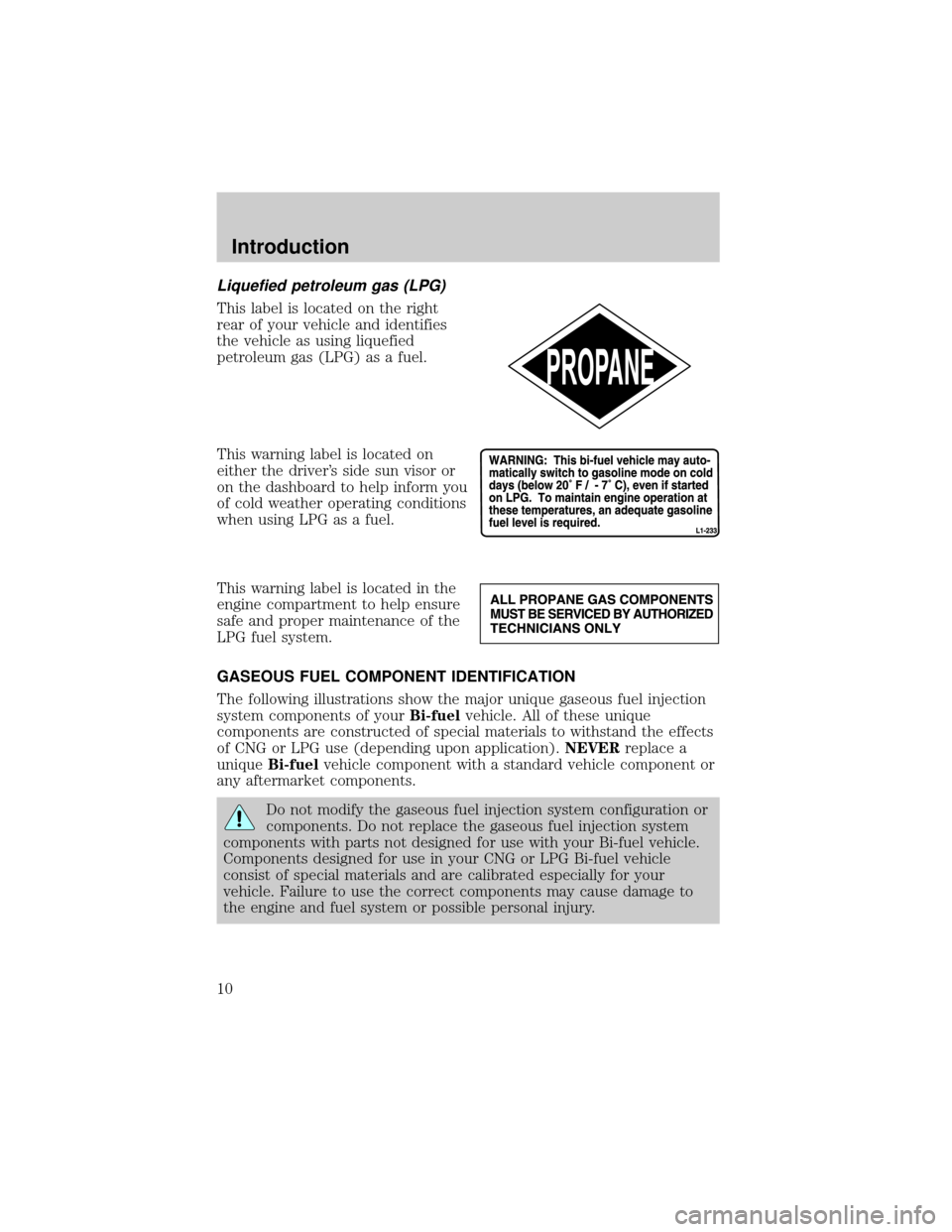Page 7 of 32
VEHICLE IDENTIFICATION AND LABELING
YourBi-fuelvehicle has several labels to identify it as a CNG or LPG
fueled vehicle (depending upon application) and to help identify areas of
special attention.
²It is important that you and others that operate yourBi-fuelvehicle
identify the label locations and understand the information on the
labels.
²Specific labels are shown within this supplement when applicable.
This label is located on the driver's
side door frame and lists the date
your gaseous fuel injection system
was installed.
This label is located on the
dashboard to remind you to operate
your vehicle regularly using
unleaded gasoline. This helps
prevent premature wear on the
components of the gasoline fuel system.
THIS VEHICLE MUST BE OPERATED ON
UNLEADED GASOLINE A MINIMUM OF
ONE TANK EVERY 60 DAYS
Introduction
7
Page 9 of 32
Compressed natural gas (CNG)
This label is located on the right
rear of your vehicle and identifies
the vehicle as using compressed
natural gas (CNG) as a fuel.
This label (required only in
California) is located on the
dashboard and identifies your
vehicle as using CNG as a fuel.
This warning label is located in the
engine compartment to help ensure
safe and proper maintenance of the
CNG fuel system.
This label is located in the engine
compartment and on the CNG
tank(s) and lists the inspection and
expiration dates for the CNG fuel
tank(s).
Introduction
9
Page 10 of 32

Liquefied petroleum gas (LPG)
This label is located on the right
rear of your vehicle and identifies
the vehicle as using liquefied
petroleum gas (LPG) as a fuel.
This warning label is located on
either the driver's side sun visor or
on the dashboard to help inform you
of cold weather operating conditions
when using LPG as a fuel.
This warning label is located in the
engine compartment to help ensure
safe and proper maintenance of the
LPG fuel system.
GASEOUS FUEL COMPONENT IDENTIFICATION
The following illustrations show the major unique gaseous fuel injection
system components of yourBi-fuelvehicle. All of these unique
components are constructed of special materials to withstand the effects
of CNG or LPG use (depending upon application).NEVERreplace a
uniqueBi-fuelvehicle component with a standard vehicle component or
any aftermarket components.
Do not modify the gaseous fuel injection system configuration or
components. Do not replace the gaseous fuel injection system
components with parts not designed for use with your Bi-fuel vehicle.
Components designed for use in your CNG or LPG Bi-fuel vehicle
consist of special materials and are calibrated especially for your
vehicle. Failure to use the correct components may cause damage to
the engine and fuel system or possible personal injury.
Introduction
10
Page 17 of 32
4. Turn the ignition to position 5
(START) without pressing on the
accelerator pedal.
5. As soon as the engine starts,
release the ignition. The ignition will
automatically return to position 4
(ON).
It is normal for the vehicle to experience longer crank times (the
amount of time the engine cranks before it starts) when started
in the gaseous fuel mode (CNG or LPG, depending upon
application).
If yourBi-fuelvehicle operates on LPG, under very cold conditions
(below ±7É C [20É F]) the gaseous fuel injection system may, as indicated
by the label on the dashboard or sun visor, automatically change to the
unleaded gasoline operating mode. For more information, refer to
Engine operationin theDrivingchapter of this supplement.
3
2
1
5
4
Starting
17
Page 19 of 32
The characteristics of LPG are unique from those of CNG, unleaded
gasoline and diesel fuel. If yourBi-fuelvehicle operates on LPG, the
gaseous fuel injection system may, as indicated by the label on the
dashboard or the sun visor, automatically change to the unleaded
gasoline operating mode under certain conditions in very cold
temperatures (below ±7É C [20É F]).
If you expect to operate your LPG Bi-fuel vehicle in very cold
temperatures, be sure to maintain an adequate supply of
unleaded gasoline in the fuel tank.
TRAILER TOWING WITH YOUR BI-FUEL VEHICLE
Refer toTowing a trailerin theDrivingchapter of the Owner's Guide
for trailer towing procedures.
Driving
19